For my family, Buca di Beppo’s Spicy Chicken Rigatoni wasn’t just dinner; it was our go-to celebration meal. It meant birthdays, promotions, Wednesdays… any excuse we could find. That big, family-style bowl was pure comfort and joy.
So when we moved away, leaving our favorite Italian spot behind felt like a genuine loss. I tried countless other recipes, but none quite captured that specific, addictive magic. I made it my mission to reverse-engineer that exact flavor in my own kitchen.
And after dozens and dozens of tests—tweaking the spices, balancing the rich cream against bright tomato, simmering the sauce just so—I finally cracked the code. While it’s a close cousin to the classic Utica-style Chicken Riggies, this recipe is obsessively engineered to be an identical match for the restaurant classic. This is the recipe.
It delivers that signature creamy ‘rose’ sauce that perfectly coats every tube of rigatoni. It has the satisfying, building heat that warms you up without being overpowering. And it features perfectly juicy, tender chicken that makes every bite perfect. This is a taste of home for my family, and I’m so thrilled to share it with yours.
Why This Recipe Is the Only One You’ll Need
- Authentic Restaurant Flavor: This recipe is obsessively engineered to replicate the famous Buca di Beppo “rose” sauce, achieving the perfect harmony of spicy marinara and rich, savory cream.
- No More Dry Chicken: My method ensures your chicken is perfectly seasoned and wonderfully juicy every single time, avoiding the most common pitfall of other recipes.
- Built-in Troubleshooting: I’ve made all the mistakes so you don’t have to. This guide includes expert tips that anticipate and solve common problems before they ever start.
- Perfectly Balanced Spice: We’re aiming for an addictive, flavorful warmth, not just raw heat. The spice blend here is designed to build delicious complexity with every bite.
Key Ingredients for the Perfect Spicy Chicken Rigatoni
A true restaurant-quality dish starts with the right ingredients. For a copycat this specific, a few key players are doing the heavy lifting. We’re seasoning the chicken itself with a little something extra—a small detail I perfected over years of testing that adds a subtle, smoky depth to the final dish.
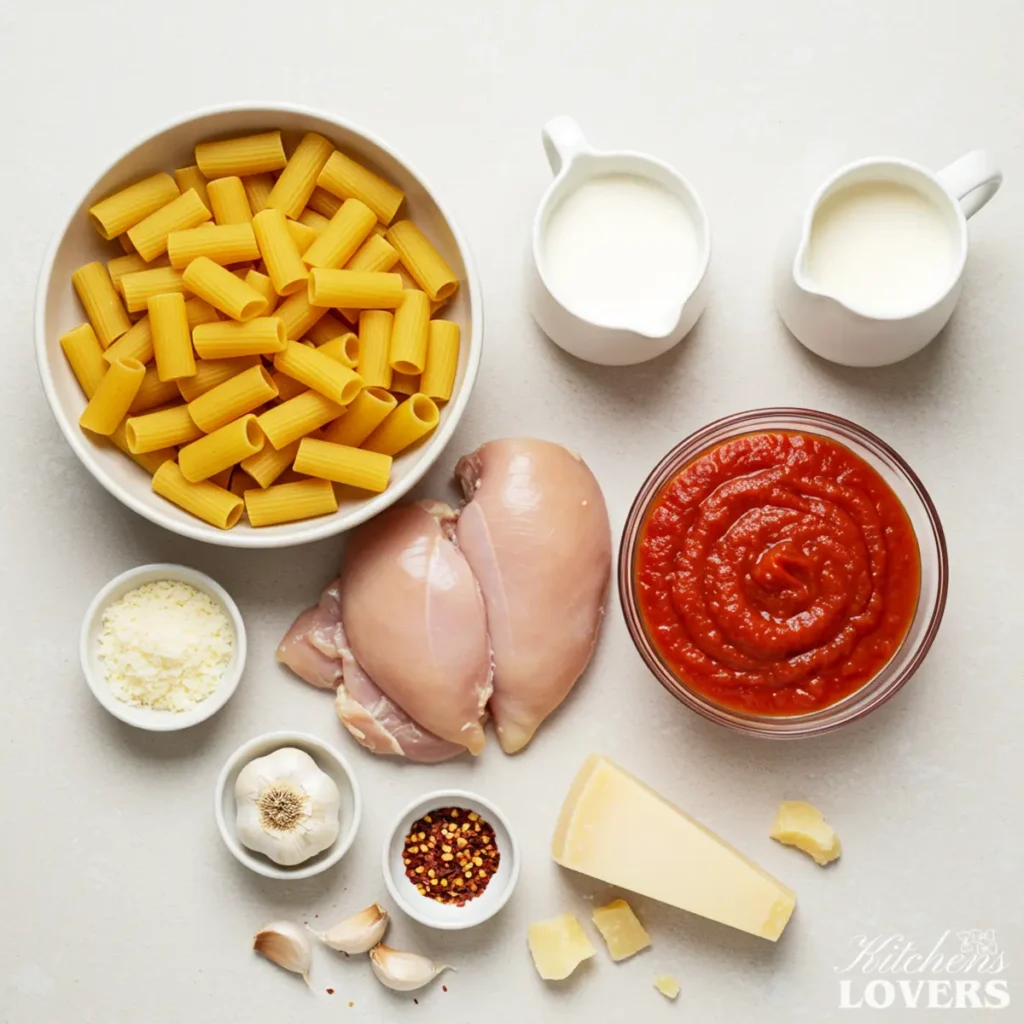
- For the Chicken & Pasta:
- 1 lb boneless, skinless chicken breast, cut into 1-inch cubes
- 1 lb of rigatoni pasta
- 2 tbsp olive oil
- Seasoning Blend: 1 tsp salt, 1/2 tsp black pepper, 1/2 tsp garlic powder, and 1/4 tsp smoked paprika
- For the Spicy Rose Sauce:
- 1 tbsp butter
- 4-6 cloves garlic, minced
- 1 tsp crushed red pepper flakes (or more, to your taste)
- 1 (24-oz) jar of high-quality marinara sauce
- 1 cup heavy cream, room temperature
- 1/2 cup chicken broth
- 1/2 cup frozen sweet peas
- 1/2 cup grated Parmesan cheese, plus more for serving
- Fresh parsley, chopped for garnish
The Secret to the Signature ‘Rose’ Sauce
The heart and soul of this recipe is the sauce. A “rose” sauce, or salsa rosa, gets its name and beautiful color from the simple combination of red marinara and white cream. But getting the balance right is what separates an okay pasta dish from a truly unforgettable one.
- High-Quality Marinara Sauce: This is my most important piece of advice. Do not skimp on the marinara. Since we aren’t building the tomato base from scratch, the quality of your jarred sauce will define the final flavor. Look for one with simple, recognizable ingredients like tomatoes, onion, garlic, and basil. A lackluster marinara will result in a bland final dish, and no amount of cream can save it.
- Full-Fat Heavy Cream: For that luxurious, velvety texture that clings to every rigatoni tube, you must use heavy cream. Please don’t be tempted to substitute with half-and-half or milk; the acid from the tomatoes is very likely to curdle lower-fat dairy, resulting in a grainy, broken sauce. Bringing the cream to room temperature before adding it also helps it incorporate smoothly into the hot sauce.
Don’t Skip the Green Peas!
I’ve seen recipes that list peas as optional, but for an authentic Buca di Beppo experience, they are absolutely essential. Think of them not as a vegetable but as a core flavor component. They provide little bursts of sweetness that cut through the richness of the cream and the warmth of the spice. That contrast is precisely what makes the dish so balanced and addictive. We use frozen peas and toss them in right at the end, so they warm through but stay bright green with a pleasant, firm pop—never mushy.
Smart Swaps & Substitutions
| Ingredient | Best Substitute | Why it Works |
| Rigatoni | Penne or Ziti | Any tube-shaped pasta with ridges will work beautifully to capture the sauce. |
| Chicken Breast | Boneless, skinless chicken thighs | Thighs offer a richer, more succulent flavor if you prefer dark meat. Sauté time may increase slightly. |
| Crushed Red Pepper | Calabrian chili paste | For a smokier, more complex heat. I explore the incredible flavor of these peppers in my Chicken Arrabbiata recipe—start with one teaspoon here and adjust. |
| Heavy Cream | Full-fat canned coconut cream | If you need a dairy-free option, this is your best bet, but be aware it will impart a subtle coconut flavor. |
Essential Equipment for Effortless Cooking
The good news is, you don’t need any fancy, single-use gadgets for this recipe. My philosophy is all about using versatile kitchen workhorses. However, for a saucy pasta dish like this, one piece of equipment makes all the difference.
- A Large, High-Sided Skillet or Dutch Oven (12-inch or larger): This is non-negotiable for a stress-free experience. A cast-iron or heavy-bottomed stainless steel skillet is my top choice because it retains and distributes heat so evenly. The generous size is crucial for three reasons:
- A Perfect Sear: It gives the chicken pieces enough space to brown properly without steaming, creating a beautiful golden-brown crust and building flavor.
- No-Splatter Sauce: It provides plenty of room to build our luxurious rose sauce without a single drop splashing over the sides and onto your stovetop.
- The Final Toss: Most importantly, you’ll have enough space to toss the cooked rigatoni right into the sauce with the chicken, ensuring every single piece is perfectly coated. Doing this in one pan is the secret to a restaurant-quality result and much less cleanup.
- You’ll also need the basics:
- A large pot for boiling the pasta
- A colander for draining
- Measuring cups and spoons
- A sharp knife and cutting board
- A whisk for smoothly incorporating the cream and Parmesan cheese
Expert Tips for Flawless Results
After making this dish more times than I can count, I’ve learned the little things that make a huge difference. These aren’t just tips; they’re the non-negotiable rules I follow to guarantee success. Think of this as your proactive troubleshooting guide.
How to Keep Your Chicken Juicy (Not Dry)
Let’s be honest, the biggest crime in a pasta dish like this is dry, chalky chicken. It’s so disappointing! But it’s also incredibly easy to avoid. The secret is to sear it hard and fast, but—and this is key—don’t cook it all the way through in the pan.
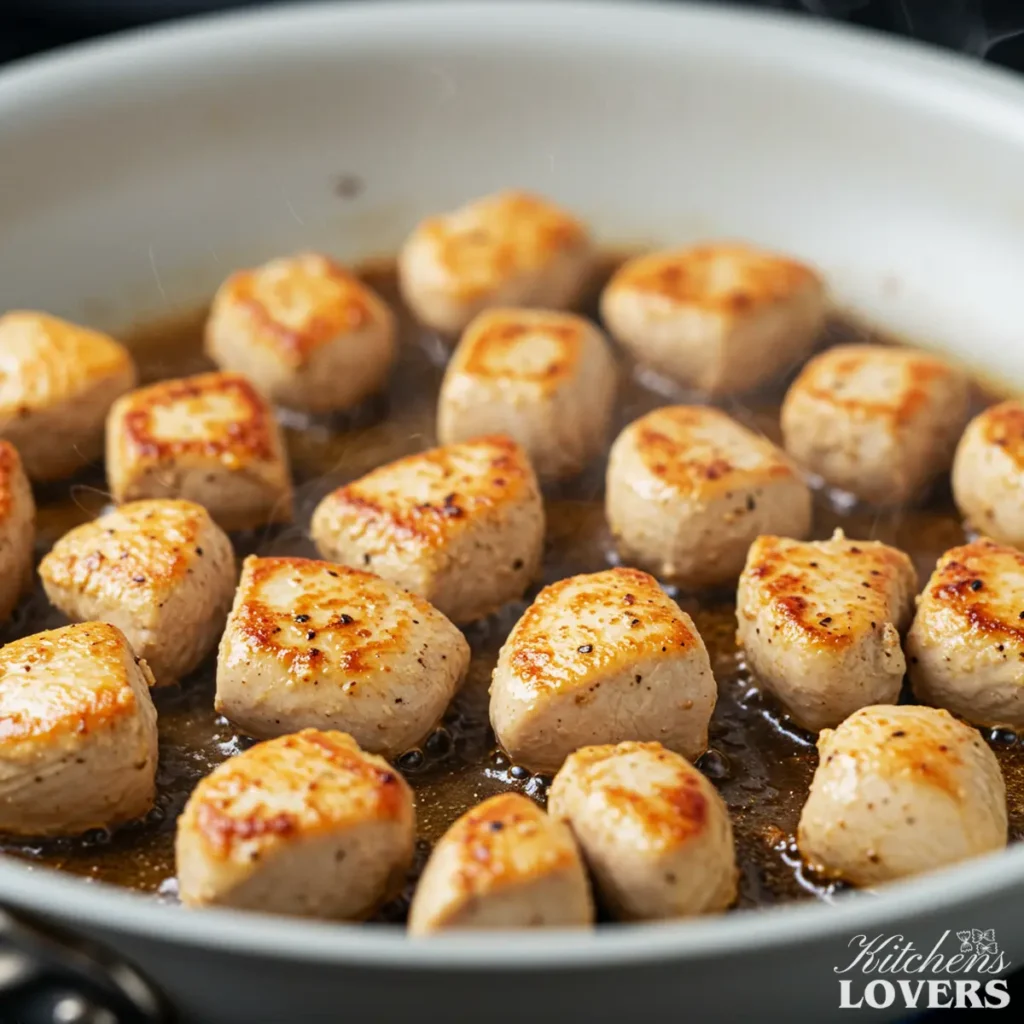
- Get Your Pan Hot: Start with a screaming hot pan and shimmering oil. This allows you to get a beautiful golden-brown crust on the chicken in just a couple of minutes. That sear isn’t just for looks; it builds a massive foundation of flavor.
- Don’t Crowd the Pan: Give the chicken cubes space. If you dump them all in at once, they’ll steam in their own juices and turn a sad, gray color. Work in two batches if you have to. It’s an extra two minutes of work that pays off tenfold in the final texture.
- The “Almost Done” Trick: This is the most important step. You want to pull the chicken from the skillet when it’s golden brown on the outside but still slightly undercooked in the very center. It will finish cooking later when you add it back into that bubbling, beautiful sauce. allowing it to become perfectly tender while reaching the correct internal temperature. For peace of mind, always verify with a meat thermometer that your chicken has reached the Safe internal temperature of 165°F.
The Trick to a Perfectly Creamy, Non-Oily Sauce
Have you ever had a cream sauce that looked greasy or slightly gritty? That’s called a “broken” sauce, where the fats and proteins have separated. It’s a common problem but completely avoidable. The two culprits are almost always heat and speed.
- Temper Your Dairy: Never add cold heavy cream directly to a ripping hot sauce. That temperature shock can cause the cream to curdle instantly. By letting your cream sit on the counter while you prep (as mentioned in the ingredients), you give it a fighting chance to incorporate smoothly. Before you pour it in, lower the heat under the skillet from medium-high to medium-low.
- Melt the Parmesan Slowly: This is the game-changer. Do not just dump your grated Parmesan cheese into the sauce and stir. That’s a surefire way to get oily clumps. Instead, turn the heat down to low and add the cheese one small handful at a time. Whisk or stir constantly, making sure each addition is fully melted and incorporated into the sauce before you add the next. This gentle method emulsifies the cheese into the sauce, creating that perfectly velvety, seamless texture you’re looking for. Trust me on this.
How to Get the Perfect Spice Level (Not Just Raw Heat)
The goal here is a delicious, building warmth that makes you want another bite, not a five-alarm fire. You are in complete control of the final heat level.
- Bloom the Spices: One of the very first steps in the recipe is to gently sizzle the crushed red pepper flakes in the butter and oil. This is a technique called “blooming.” It wakes the spices up, unlocking their smoky, nuanced flavor instead of just their raw, sharp heat. Don’t skip this.
- Start Low, Go Slow: The recipe calls for 1 teaspoon of red pepper flakes, which I consider a pleasant, happy medium that delivers noticeable warmth. If you’re sensitive to heat or cooking for kids, start with just 1/2 teaspoon. You can always taste the finished sauce (before adding the pasta) and stir in a bit more if you’d like.
- The Rescue Tip: If you went a little too far with the pepper flakes, don’t panic! Simply stir in an extra splash of heavy cream or a small pinch of sugar. The fat in the cream and the sweetness from the sugar will both help to balance and tame the spice, smoothing everything out.
Step-by-Step Instructions
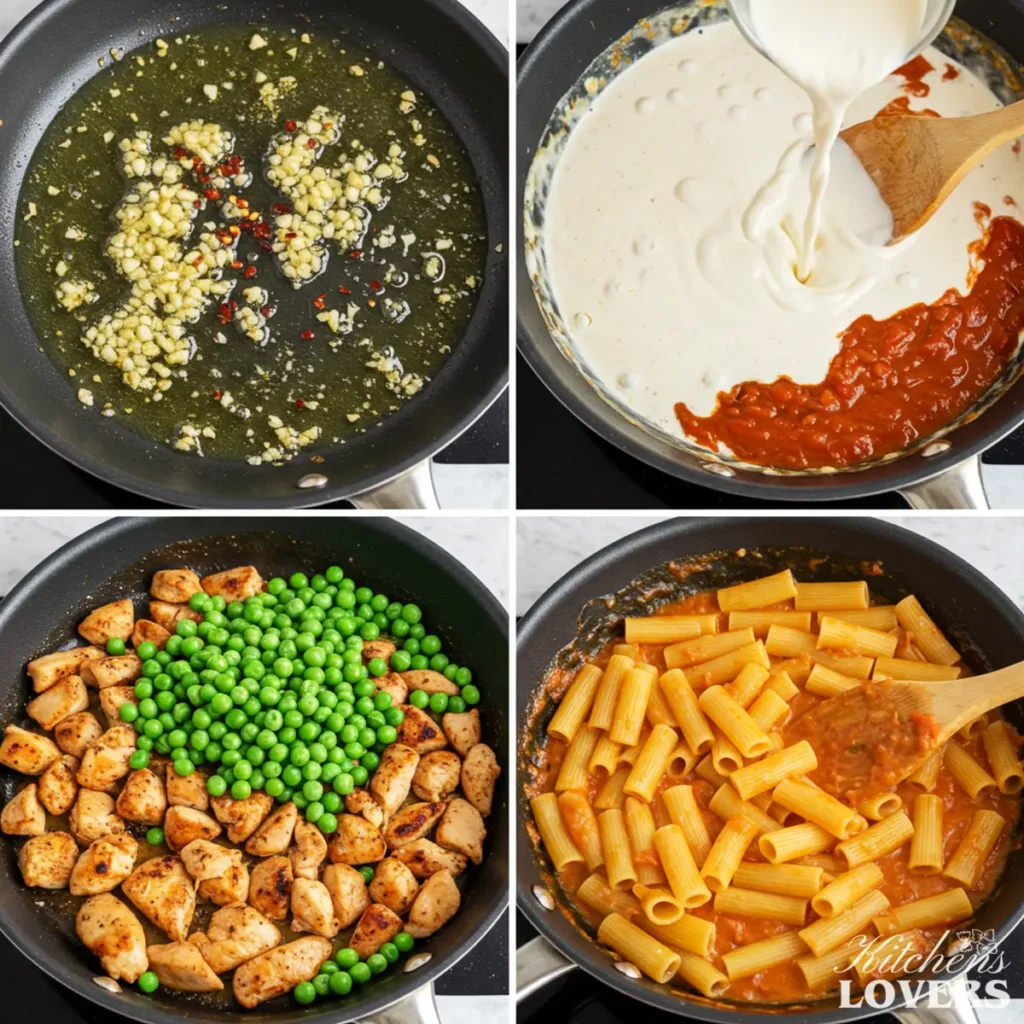
Cook the Pasta:
Bring a large pot of heavily salted water to a rolling boil. Add the rigatoni and cook according to package directions until it’s just al dente (firm to the bite). Before you drain, reserve about one cup of the starchy pasta water, then drain the rigatoni in a colander and set it aside.
Season and Sear the Chicken:
While the water is coming to a boil, pat your cubed chicken dry with paper towels. Toss it in a bowl with the seasoning blend (salt, pepper, garlic powder, and smoked paprika) until it’s evenly coated. Heat the olive oil in your large skillet or Dutch oven over medium-high heat. Once the oil shimmers, add the chicken in a single layer—you should hear a confident sizzle. Cook for 2-3 minutes per side, until it’s beautifully golden-brown but not fully cooked through. Use a slotted spoon to transfer the chicken to a clean plate and set it aside.
Bloom the Aromatics:
Reduce the heat to medium. Add the tablespoon of butter to the same skillet, letting it melt into the leftover chicken drippings. Add the crushed red pepper flakes and let them sizzle for about 30 seconds until you can smell their gentle, toasty warmth. Now, add the minced garlic and sauté for another 30-60 seconds. Sizzle the minced garlic just until that nutty, irresistible aroma starts to perfume your entire kitchen. Be careful not to let it burn.
Build the Rose Sauce:
Pour in the chicken broth to deglaze the pan, using a wooden spoon to scrape up any delicious browned bits from the bottom. Let it simmer and reduce for about a minute. Now, stir in the entire jar of marinara sauce. Bring the mixture to a lively simmer and let it cook for about 5 minutes, allowing the flavors to meld. You’ll see the sauce thicken slightly.
Add the Cream & Cheese:
Turn the heat down to low. Slowly pour in the room-temperature heavy cream, stirring constantly. You’ll see the sauce instantly transform from a vibrant red to a beautiful, velvety rosé color. Once the cream is fully incorporated, begin adding the grated Parmesan cheese, one small handful at a time. Stir well, making sure each addition is completely melted before you add the next. Your sauce should now look incredibly glossy and rich.
Bring It All Home:
Add the seared chicken and any juices from the plate back into the sauce. Stir in the frozen peas. Let everything simmer gently for another 2-3 minutes, just long enough for the chicken to finish cooking and for the peas to become tender-crisp. Taste the sauce now and adjust if you’d like a bit more salt or red pepper flakes.
Combine and Serve:
Add the drained rigatoni directly to the skillet with the sauce. Toss everything together gently but thoroughly until every single piece of pasta is coated in the glorious sauce. If the sauce seems a little too thick, stir in a splash of that reserved pasta water until it reaches your desired consistency. Serve immediately in warm bowls, garnished with a sprinkle of extra Parmesan and a scattering of fresh parsley.
The Anatomy of a Perfect ‘Rose’ Sauce
A true Buca di Beppo-style “rose” sauce is so much more than just a mixture of marinara and cream. It’s a culinary transformation where two ingredients become something entirely new and far more delicious. Understanding the simple science behind it is the key to mastering the recipe and moving from just following steps to truly cooking.
Here’s the beautiful science behind why it works so perfectly:
The Flavor: Taming Acidity with Fat
Think of a straight marinara sauce. It’s wonderful, but it has bright, sharp, acidic edges. On its own, that acidity can sometimes overpower delicate flavors. Now, introduce heavy cream. The fat in the cream is a magical ingredient that coats the palate and physically softens the perception of that sharp acidity. It doesn’t erase the bright tomato flavor; it rounds it out, creating a sauce that is beautifully balanced, rich, and complex. This is also why the spiciness in our recipe feels like a pleasant, building warmth rather than a sharp, raw heat—the fat mellows it into something far more luxurious.
The Texture: Building a Velvety Emulsion
The second piece of the puzzle is texture. You can’t just dump cream into marinara and hope for the best. The goal is to create a stable emulsion—a smooth, seamless binding of the water-based marinara and the fat-based cream. This is where the real magic happens. By reducing the heat and slowly stirring in the room-temperature cream and Parmesan, we encourage the fat globules to disperse evenly throughout the tomato base. The gentle simmering that follows allows this bond to strengthen, creating that signature, restaurant-quality velvety consistency. The result is a sauce that’s glossy and substantial, engineered to cling perfectly to every single ridge and tube of the rigatoni instead of just pooling sadly at the bottom of your bowl.
Pro Variations to Customize Your Dish
Think of this base recipe as the perfect canvas. If you’re ready to play with the flavors, here are a couple of my favorite, rigorously tested twists that I know you’ll love.
For the Extra-Spicy Lover
If my “happy medium” of spice isn’t quite enough for you, there are a few ways to correctly layer in more heat for maximum flavor, not just a raw burn.
- Double Down: The easiest way to increase the heat is to simply increase the crushed red pepper flakes from 1 teaspoon to 2, blooming them in the butter and oil as directed. This will give you a significant, undeniable kick.
- Add Fresh Fire: For a brighter, punchier heat, add one finely diced serrano or Fresno chili to the skillet along with the minced garlic. Sautéing the fresh chili will infuse the base of the sauce with a more vibrant, immediate spice that complements the slow warmth of the flakes beautifully.
- Introduce Smoky Depth: As I mentioned in the substitutions, swapping the flakes for 1-2 teaspoons of Calabrian chili paste will give you a robust, smoky, and deeply flavorful heat that is absolutely incredible in this sauce.
Add a Veggie Boost: Mushrooms & Spinach
For a fantastic, veggie-packed version, we can add savory mushrooms and fresh spinach. This gives the dish an earthy depth and a boost of green without changing the soul of the sauce.
- The Add-ins: You’ll need 8 ounces of cremini (baby bella) mushrooms, sliced, and one 5-ounce bag of fresh baby spinach.
- The Method: This requires just two small additions to the cooking process.
- Sauté the Mushrooms: After you sear the chicken and remove it from the skillet (at the end of Step 2), add the sliced mushrooms to the hot pan. Let them cook for 5-7 minutes, stirring occasionally, until they’ve released their water and are nicely browned and caramelized. Transfer them to the plate with the chicken.
- Wilt the Spinach: At the very end, right after you’ve combined the chicken and peas with the sauce (Step 6), add the entire bag of fresh spinach. Stir for just 1-2 minutes. The heat from the sauce will wilt it down perfectly without it becoming watery. Then, proceed with Step 7 and add the pasta. The result is a wonderfully complete one-pan meal.
Storing & Reheating Leftovers Like a Pro
Cream-based pasta sauces are notoriously tricky to reheat, often turning into a sad, oily mess in the microwave. But don’t worry. My method is foolproof and will restore your leftovers to their original glory, ensuring that the second-day serving is just as delicious as the first.
How to Store It
- Fridge: Allow the spicy chicken rigatoni to cool to room temperature, then transfer it to an airtight container. It will keep beautifully in the refrigerator for up to 3 days.
- Freezing: I generally don’t recommend freezing this dish. The dairy in the sauce has a tendency to separate and become grainy upon thawing, and the texture of the pasta can become mushy. This recipe is definitely best enjoyed fresh or reheated from the fridge.
The Secret to Perfect, Creamy Reheating
The enemy of a leftover cream sauce is high, direct heat. A blast from the microwave is the fastest way to “break” the sauce, forcing the fats to separate from the liquid. The result is an oily, unappealing puddle.
The key to success is gentle heat and a little extra moisture to help the sauce’s emulsion come back together.
The Stovetop Method (Best by Far):
- Place Leftovers in a Skillet: Add your desired portion of leftover pasta to a cold, non-stick skillet or a small saucepan.
- Add a Splash of Liquid: This is the most important step. For a single serving, add a tablespoon or two of milk, chicken broth, or even a splash of heavy cream. This extra liquid is what helps reconstitute the sauce and bring back its original creamy texture.
- Heat Gently and Stir: Place the skillet over low to medium-low heat. As the pasta begins to warm up, stir it gently but frequently. You will literally see the sauce transform—it will go from a bit clumpy and thick to smooth, glossy, and perfectly creamy as the fat re-emulsifies.
- Serve Immediately: The process only takes about 5-7 minutes. Once it’s warmed through and creamy, plate it and enjoy immediately. It will taste like you just made it fresh.
This method works because the slow, even heat and the added liquid give the fats in the sauce time to gently melt back into the emulsion rather than separating out. It’s a little science and a little magic, and it works every time.
What to Serve With This Spicy Chicken Rigatoni
This rigatoni is a powerhouse of flavor all on its own—rich, spicy, and deeply satisfying. So, when it comes to side dishes, the goal is to provide a little contrast that makes the main dish shine even brighter. Here are my go-to pairings that never fail.
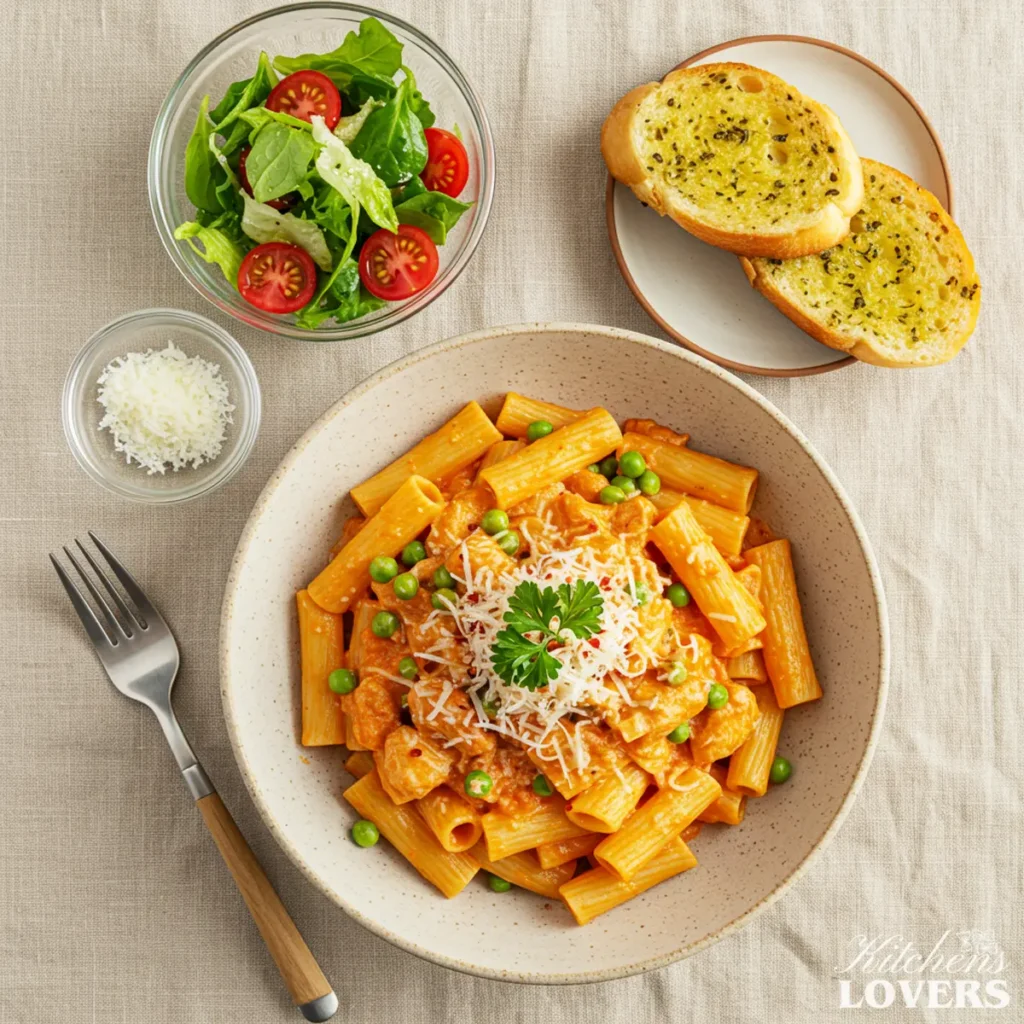
- Something Crisp and Refreshing: You absolutely need something bright and crisp to cut through the richness of that rose sauce. A simple salad of mixed greens, maybe some shaved Parmesan and cherry tomatoes, is perfect. The key is the dressing: forget the heavy, creamy stuff. A sharp, tangy lemon vinaigrette is what you want. That pop of acidity is like hitting a refresh button for your palate between bites of the creamy pasta.
- A Tool for the Sauce: For me, serving this pasta without some form of crusty, buttery garlic bread is practically a crime. It’s the perfect companion for any rich, spicy tomato sauce, whether it’s this creamy rosé or the classic fiery red sauce in my Chicken Arrabbiata. It’s essential for chasing that last bit of sauce around the bowl.
- An Easy, Earthy Green: When I want an easy, healthy side that adds color and texture to the plate, I turn to simple roasted greens. A handful of asparagus spears or broccoli florets tossed with olive oil, salt, and pepper and roasted at high heat (400°F/200°C) until they’re tender with slightly crispy, charred edges is all you need. They provide a wonderful, earthy contrast to the spicy sauce.
Frequently Asked Questions (FAQs)
Here are answers to some of the most common questions I get about this recipe. If you have another one, please feel free to ask in the comments!
Spice & Pasta Options
I would describe the spice level in the recipe as written (with 1 teaspoon of crushed red pepper flakes) as a solid “medium.” It provides a pleasant, noticeable warmth that builds as you eat, but it won’t set your mouth on fire. It’s designed to be flavorful, not just hot. The great news is you have total control! For a milder version, start with just 1/2 teaspoon. For a truly “spicy” dish, go ahead and use 2 teaspoons.
Absolutely. While rigatoni is my top choice because its large tubes and ridges are perfect for catching this rich, thick sauce, other shapes work wonderfully. Penne rigate (the kind with ridges) is an excellent substitute. Ziti, garganelli, or even large shells would also be delicious. The main goal is to use a sturdy pasta shape that can hold its own and provide little pockets for the sauce to cling to. I would avoid long, thin pastas like spaghetti or angel hair, as they would be overwhelmed by the hearty sauce.
Make-Ahead & Sauce Secrets
Yes, you can definitely prep parts of this recipe ahead of time to make dinner assembly a breeze. Here’s my recommendation:
Make the Sauce: You can prepare the entire rose sauce (through Step 5) and sear the chicken. Let them cool completely and store them in separate airtight containers in the refrigerator for up to 2 days.
When Ready to Serve: Gently reheat the sauce in a large skillet over medium-low heat. While it’s warming, cook your rigatoni according to package directions. Add the cooked chicken and frozen peas to the sauce to warm through, and then toss with the freshly drained pasta. This method ensures the best possible texture for the pasta and sauce.
That’s the secret to the famous “rose” (or salsa rosa) sauce! This combination is the key to creating the authentic restaurant copycat flavor. The marinara provides the foundational layer of flavor—bright, acidic tomato, garlic, and herbs. But on its own, it can be sharp. The heavy cream is what transforms it, adding a luxurious, velvety richness that balances the acidity, mellows the spice into a pleasant warmth, and gives the sauce its signature, beautiful rosé color. It truly gives you the best of both worlds.
We’d Love to Hear From You!
And there you have it—the taste of my family’s favorite celebration meal, straight from my kitchen to yours. I’ve poured years of testing and a lot of love into this recipe, and I truly hope it becomes a new favorite for you, too.
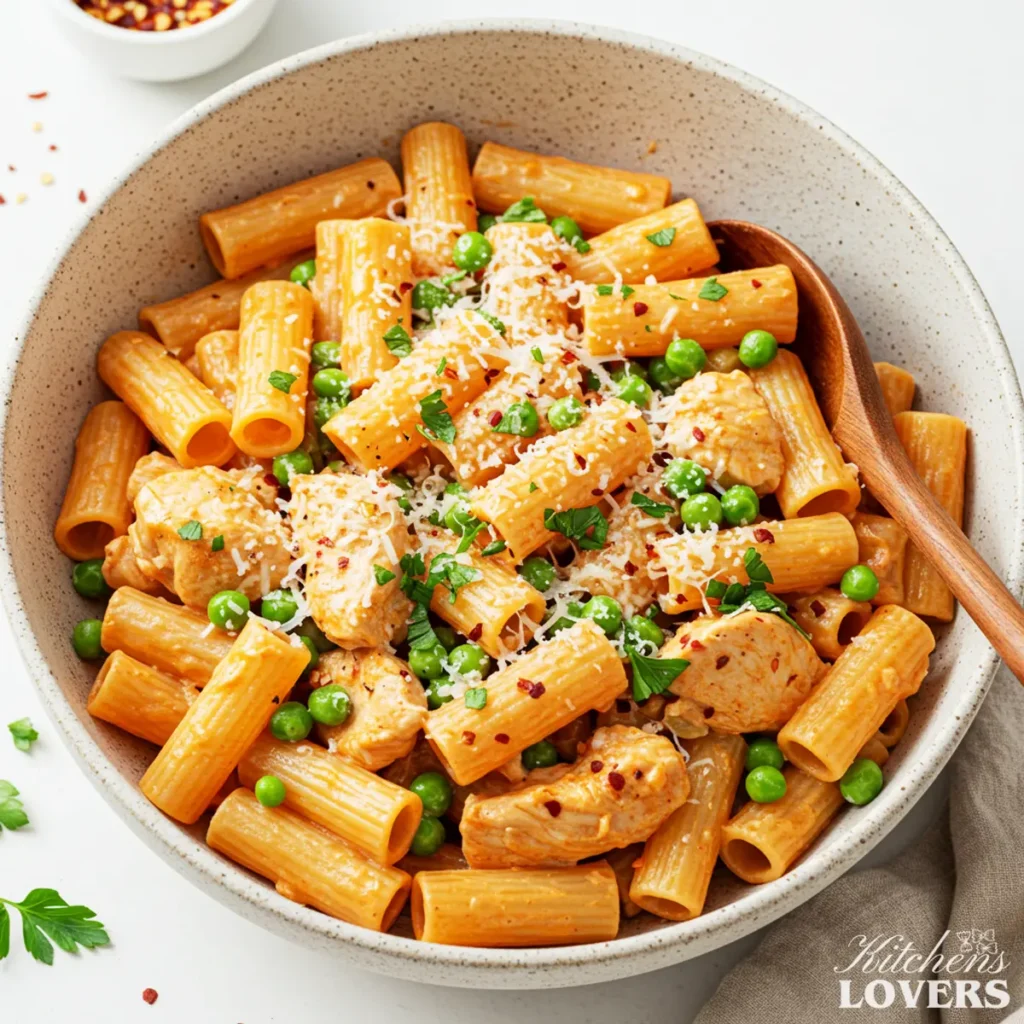
There is nothing better than seeing my recipes come to life in your kitchens. If you make this Spicy Chicken Rigatoni, please leave a star rating and a comment below. I’d especially love to know: did this taste just like the restaurant version for you? Your feedback makes this whole process worthwhile!
More Flavor-Packed Dinners to Explore
If you loved the flavor profile of this dish, you’re in the right place! For more ideas on how to turn up the heat at dinner time, be sure to check out my complete collection of Spicy Chicken Pasta Recipes. You’re sure to find your next weeknight obsession.
Want easy, family-tested recipes sent straight to your inbox? Sign up for our newsletter! We’ll send you our latest creations, pro tips, and menu ideas to make dinnertime your favorite time of day.
About Kate Thompson
Kate Thompson created KitchensLovers.com to simplify dinner for real-life families. She develops easy, flavor-packed chicken pasta recipes tested dozens of times to guarantee results. Her motto: ‘Easy Pasta, Every Time.’
This recipe was last tested and updated in September 2025 to ensure perfect results.
Spicy Chicken Rigatoni Recipe
Equipment
- Large, High-Sided Skillet or Dutch Oven (12-inch)
- Large Pot (for pasta)
- Colander
- Whisk
- Measuring Cups and Spoons
Ingredients
For the Chicken & Pasta
- 1 lb boneless skinless chicken breast, cut into 1-inch cubes
- 1 lb Rigatoni pasta
- 2 tbsp Olive oil
For the Seasoning Blend
- 1 tsp salt
- 1/2 tsp black pepper
- 1/2 tsp garlic powder
- 1/4 tsp smoked paprika
For the Spicy Rose Sauce
- 1 tbsp butter
- 4-6 cloves garlic minced
- 1 tsp crushed red pepper flakes or more, to your taste
- 1 24-oz jar high-quality marinara sauce
- 1 cup heavy cream at room temperature
- 1/2 cup chicken broth
- 1/2 cup frozen sweet peas
- 1/2 cup grated Parmesan cheese plus more for serving
- Fresh parsley chopped, for garnish
Instructions
- Cook the Pasta: Bring a large pot of heavily salted water to a rolling boil. Add the rigatoni and cook according to package directions, until al dente. Before draining, reserve about one cup of the starchy pasta water, then drain the rigatoni.
- Season and Sear the Chicken: While water is boiling, pat chicken dry and toss in a bowl with the seasoning blend (salt, pepper, garlic powder, paprika). Heat olive oil in a large skillet over medium-high heat. Add chicken in a single layer and cook for 2-3 minutes per side, until golden-brown but not fully cooked. Transfer chicken to a plate.
- Bloom the Aromatics: Reduce heat to medium, add butter to the skillet. Add crushed red pepper flakes and sizzle for 30 seconds. Add minced garlic and sauté for another 30-60 seconds until fragrant, being careful not to burn.
- Build the Rose Sauce: Pour in the chicken broth to deglaze, scraping up any browned bits. Let it simmer for a minute. Stir in the marinara sauce, bring to a lively simmer, and cook for 5 minutes to meld the flavors.
- Add the Cream & Cheese: Turn heat to low. Slowly pour in the room-temperature heavy cream, stirring constantly until the sauce turns a rosé color. Add the grated Parmesan cheese in small handfuls, stirring until each addition is fully melted before adding the next.
- Bring It All Home: Add the seared chicken and any juices from the plate back into the sauce. Stir in the frozen peas. Simmer gently for 2-3 minutes for the chicken to finish cooking and the peas to warm through. Taste and adjust seasoning if needed.
- Combine and Serve: Add the drained rigatoni to the skillet. Toss everything together until the pasta is coated. If the sauce is too thick, stir in a splash of reserved pasta water. Serve immediately, garnished with extra Parmesan and fresh parsley.
Notes
- Expert Tip for Juicy Chicken: Don’t cook the chicken all the way through when searing. It will finish cooking in the sauce, ensuring it stays tender and juicy.
- Tip for a Creamy Sauce: Always use room-temperature heavy cream and lower the heat before adding it to prevent curdling. Add Parmesan slowly and stir until melted to avoid an oily sauce.
- Control the Spice: ‘Blooming’ the red pepper flakes in the hot oil brings out their flavor, not just their raw heat. Start with 1/2 tsp for mild and adjust to your preference.
